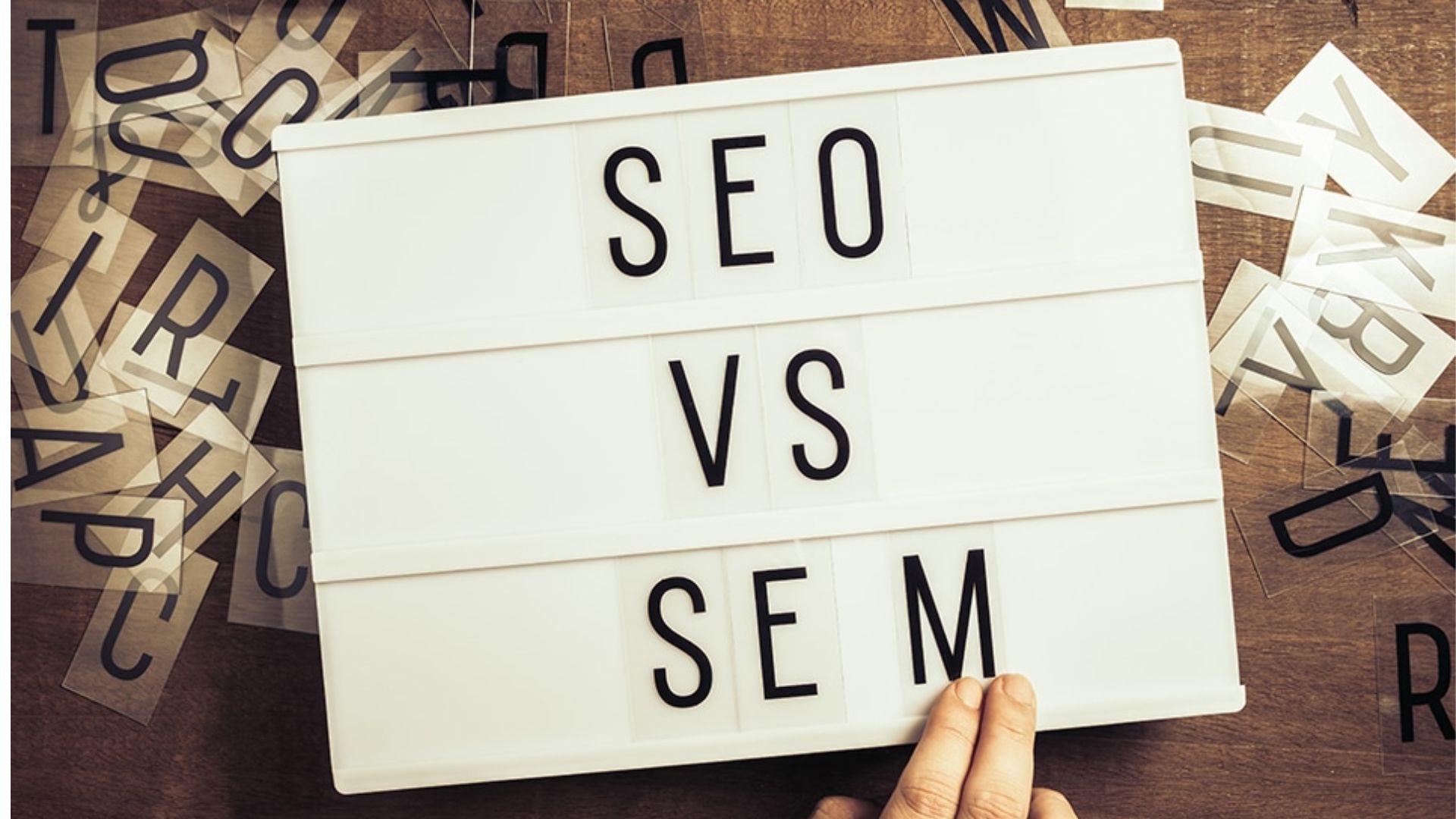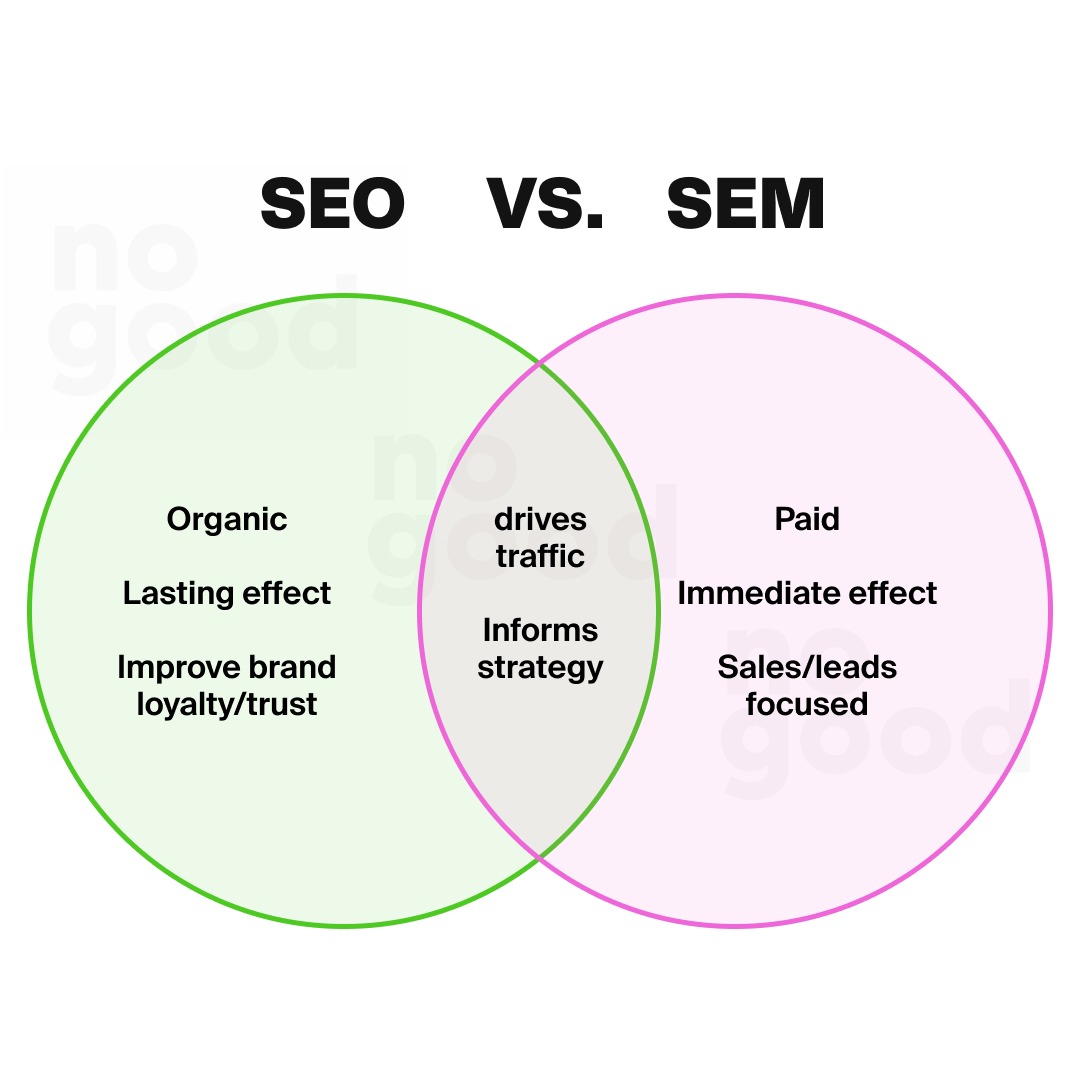
Two phrases that often come up as pillars of online exposure in the always-changing field of digital marketingare SEO(Search Engine Optimization) and SEM (Search Engine Marketing).
Even though they are related, these tactics use different methods to accomplish the same objective, which is improving internet visibility and increasing website traffic. To optimize their digital presence, marketers, company owners, and content creators need to understand the subtle differences between SEO and SEM.
While SEM enables rapid, focused exposure, SEO concentrates on organic development and creating a solid foundation for your website. Both are essential components of a thorough digital marketing plan, but how well they are understood and applied will determine how effective they are.
“„In Short! SEO concentrates entirely on achieving high rankings in organic search results, while SEM integrates both SEO and PPC strategies to drive traffic from search engines effectively.
This article aims to demystifySEO vs SEM, highlighting their differences, individual strengths, and how they can be synergistically used to create a robust online marketing strategy. Comprehending the differences between SEO and SEM is essential for everyone venturing into the digital marketing space, regardless of experience level.
What Is SEO?
SEO involves the ongoing optimization of a website to secure rankings in the unpaid, organic search engine results pages (SERPs). Google employs over 200 ranking signals in its algorithm, leading to the categorization of SEO into four primary subcategories: on-page SEO, off-page SEO, technical SEO, and User Interaction Signals.
In order for a company to be seen in search results, more is needed for them to have a website established; they also need to have an experienced digital marketer apply search engine optimization.
On-Page SEO
On-page SEO is the meticulous process of enhancing individual page content to achieve higher rankings on Google. This involves various activities, such as optimizing title tags and URL slugs, incorporating header tags, and more.
To optimize your content for target keywords, make your page Google-friendly, and enhance user engagement, follow this comprehensive on-page SEO checklist:
Keyword Research
Conduct thorough keyword research to identify relevant and high-traffic keywords for your content.
Optimize Title Tag
Create compelling and keyword-rich title tags that accurately represent the content of your page.
Use H1 Tags For Headlines
Structure your content with clear and concise headlines, utilizing H1 tags for the main title.
Meta Description Optimization
Craft engaging meta descriptions that encourage clicks and accurately summarize the page's content.
SEO-Friendly URL Structure
Ensure that your URL structure is concise and descriptive and includes target keywords when possible.
Keyword Integration In Content
Naturally, incorporate target keywords into your content while maintaining readability and relevance.
Content Quality Check
Regularly assess and enhance the quality of your content to meet user expectations and search engine standards.
Header Tag Usage
Utilize header tags (H2, H3, etc.) to structure your content and highlight key sections for both users and search engines.
Internal Linking
Enhance navigation and distribute link equity by strategically incorporating internal links within your content.
Visual Content Optimization
Optimize images with descriptive file names and alt text, enhancing both user experience and search engine understanding.
Implement Schema Markup
Use schema markup to provide additional context to search engines about the content on your page.
Bonus Tasks
Mobile Optimization
Ensure your website is mobile-friendly, providing a seamless experience for users on various devices.
Page Load Speed Optimization
Optimize page load times by compressing images, leveraging browser caching, and minimizing unnecessary code.
User Engagement Metrics
Monitor user engagement metrics such as bounce rate, time on page, and click-through rate to gauge content effectiveness.
By diligently addressing these on-page SEO tasks, you can enhance the visibility, relevance, and overall performance of your web pages in search engine results.
Off-Page SEO
Off-page SEO involves optimizing factors external to your website to enhance its visibility and authority in search engine results. This checklist outlines 11 essential tasks (with three bonus tasks) to strengthen your off-page SEO strategy and boost your website's overall performance:
Off-page SEO involves optimizing factors external to your website to enhance its visibility and authority in search engine results. This checklist outlines 11 essential tasks (with three bonus tasks) to strengthen your off-page SEO strategy and boost your website's overall performance:
Build High-Quality Backlinks
Seek reputable and relevant websites to acquire quality backlinks. Focus on natural link-building strategies.
Social Media Presence
Establish a strong presence on social media platforms to increase brand visibility and attract a broader audience.
Online Reputation Management
Monitor and manage your online reputation by responding to reviews and addressing customer feedback promptly.
Guest Blogging
Contribute high-quality guest posts to authoritative websites in your industry to build credibility and gain backlinks.
Influencer Partnerships
Collaborate with influencers in your niche to leverage their audience and enhance your brand's credibility.
Social Bookmarking
Share your content on social bookmarking sites to increase visibility and drive traffic.
Brand Mentions
Monitor and encourage mentions of your brand across the web to build authority and credibility.
Local SEO Strategies
Optimize your website for local searches by claiming and updating your Google My Businesslisting and obtaining local citations.
Forum Participation
Engage in relevant forums and communities to establish your expertise and build backlinks.
Broken Link Building
Identify broken links on authoritative websites and propose your content as a replacement, earning valuable backlinks.
Content Promotion
Actively promote your content through various channels, such as email newsletters, to increase its reach and attract more backlinks.
Bonus Tasks:
Monitor Competitor Backlinks
Analyze competitor backlink profiles to identify potential linking opportunities and stay competitive.
Participate In Industry Events
Attend and participate in industry events, conferences, and webinars to network and enhance your online presence.
Create Shareable Infographics
Develop visually appealing infographics related to your industry to encourage sharing and backlink acquisition.
By systematically addressing these tasks, you can fortify your off-page SEO efforts and contribute to the overall success of your website in search engine rankings.
Key Features Of SEO
The goal of the diverse field of search engine optimization (SEO) in digital marketing is to raise a website's exposure and position in search engine results pages (SERPs). Its main characteristics include many strategies and best practices that combine to optimize websites for search engines and visitors.
Keyword Research And Optimization
Researching keywords is the cornerstone of SEO. It entails locating and examining the words and phrases that prospective clients enter into search engines. To increase relevance and search ranks, intentional keyword integration into website content, titles, meta descriptions, and URLs is a critical component of effective SEO.
Content Quality And Relevance
Relevant, high-quality content is essential for SEO performance. Content that offers users value is well-written, and informative is preferred by search engines. Adding new, unique material to the website on a regular basis maintains it current and search engine friendly.
Technical SEO
This entails fine-tuning the technological components of the website to strengthen its framework and organization.
Crucial elements encompass optimizing website performance, guaranteeing responsiveness on mobile devices, encrypting the website via HTTPS, and generating an XML sitemap to facilitate better site crawling by search engines.
User Experience (Ux)
These days, SEO is about providing a positive user experience in addition to appealing to search engines. A website that is well-designed, user-friendly, and easy to use may increase visit durations and decrease bounce rates, all of which are good for SEO.
Local SEO
Local SEO is essential for companies that cater to certain geographic locations. It includes monitoring local listings and citations, obtaining local reviews, optimizing for Google My Business, and optimizing the website for local search queries.
When combined, these elements create a strong SEO strategy that helps websites rank better in search engine results pages (SERPs), increase traffic, and eventually accomplish their digital marketing objectives.
Search Engine Marketing (SEM)
Although search engine optimization (SEO) concentrates mainly on organic methods, search engine marketing (SEM) makes use of paid advertising to increase your company's visibility. PPC/CPC, AdWords, retargeting, geotargeting, mobile search advertising, and other paid techniques are all included in SEM.
Search engine marketing (SEM) is expected to maintain its dominance in online expenditure, accounting for 47% of the share or approximately 14% of overall marketing budgets.
Paid advertisements can target certain audiences based on their geography, interests, and other variables. They are displayed as sponsored listings on Google search results pages.
In a short amount of time, using SEM tactics will help you reach more potential clients and increase your company's internet presence. To make sure you're receiving the most value for your money, you must constantly evaluate your ad campaigns and make adjustments as needed. SEM campaigns are not a "set it and forget it" approach.
Ppc/Cpc
Ads can be placed at the top or bottom of a search engine results page, or SERP, using pay-per-click search engine marketing. The advertiser is billed the predetermined amount, or cost-per-click, each time a click is made on one of these "sponsored" advertisements.
Adwords
Businesses may post advertisements on Google's partner sites and search engine results pages (SERPs) using this SEM tool. The keywords and phrases you select to target, together with the user's location, search history, and other variables, are taken into account when displaying the adverts.
With AdWords, your company can manage the amount of money it spends on advertising campaigns, the duration of the advertisements, and the websites the ads show on.
Retargeting/Remarketing
By doing this, you may connect with users who have previously engaged with your website. It entails showing targeted advertisements to those who have already visited your website, looked up your items online, or expressed interest in what you have to offer.
Because it lets you target those who are already familiar with your brand, this kind of advertising may be exceptionally successful.
Geotargeting
Companies may send ads to clients using this SEM tactic, depending on their location. Companies can target individuals based on their demographics, activity, or location. This makes it possible for firms to concentrate their advertising efforts on regions or demographics that are more likely to be interested in their goods or services.
Mobile Search Advertising
With this SEM approach, you may target customers who are looking for keywords associated with your brand on mobile devices, including tablets and smartphones, by placing advertisements on these platforms.
How Can SEM Help You Reach Your Marketing Goals?
Linking with your target audience is the primary way search engine marketing may assist you in achieving your digital marketing objectives.
Even if you have an excellent product or service, you won't get the desired return on investment (ROI) if no one knows about it. Furthermore, failing to use SEM exposes you to being outperformed by the competitors.
In order for people looking for what you have to offer to contact you, paid search search engine marketing (SEM) can help you rank highly on search engine results pages (SERP).
In the meanwhile, SEO strategies are built to last (and withstand algorithm changes that frequently occur when new versions are released). You may become recognized as a reliable source of information and a thought leader in the field by using search engine optimization to move up the organic results pages.
Key Differences Between SEO And SEM
While SEO and SEM both assist businesses in attracting online visitors, marketers should be aware of the main distinctions between them, including the kinds of search results they focus on, how long it takes them to get results, and how much they cost overall.
“„SEO is employed by 64% of B2B technology companies to promote their products, although the reasons for the remaining 36% not utilizing SEO are unclear. Additionally, 59% of these companies utilize paid search or SEM as part of their marketing strategies.
SEO And SEM Target Different Search Results
The main objective of both SEO and SEM is to raise an organization's search engine presence. However, they each concentrate on distinct approaches to achieving that objective.
Building and improving webpages is the main goal of SEO in order to raise their positions in natural search results. Using bought ads to rank first in SERPs is the main goal of SEM.
Marketers employ SEO best practices to provide content that search engine algorithms tend to like in order to help sites rank organically. Despite the fact that search engines like Google and Bing don't provide all the specifics of their algorithmic ranking processes, the algorithms consider hundreds of factors, such as the following;
- Tags for titles - The primary keyword of the content, or a variant thereof, should be in the title of a page.
- Content quality - Writers of content should provide well-structured, comprehensive, and well-written pieces.
- Adaptability to mobile devices - Search engines give preference to websites that load quickly in mobile browsers as more users perform searches from their mobile devices.
- Websites having a lot of backlinks -links pointing to other websites usually show up high in search engine results.
- Site velocity - Search engine providers prefer sites that load quickly in their algorithms since they don't want to direct people to sluggish websites.
Marketing teams may utilize the guidelines mentioned earlier as a reference when creating digital content as part of an SEO plan. Creative teams may ultimately rank on the first page or in the top spot on Google for the keyword or phrase that describes their content by using these SEO best practices, all without having to pay for those top rankings.
Conversely, with SEM, advertisers use sponsored listings to show up first in search engine results pages (SERPs) for relevant keywords and phrases. Search and commerce advertisements are the two main categories of SEM advertising on Google.
- Search advertisements- Businesses can bid for a term or phrase to have a link to their page show up on search engine results pages (SERPs) for that term. These advertisements employ a pay-per-click (PPC) business model, whereby users are charged a fee each time an ad is clicked.
- Advertisements for shopping- These advertisements are PPC-based as well, but they connect to a company's online storefront via Google Shopping. These advertisements display the product's picture in addition to its price and title.
SEO Takes Longer To Deliver Results Than SEM
Compared to SEM, SEO takes longer to provide results. While an SEM campaign may boost an organization's online traffic in a matter of hours, an SEO plan may take anywhere from three months to two years to provide noticeable ranking changes.
Search engines are used by millions of individuals to discover the goods and services they seek, making the digital marketing sector extremely competitive.
Building a vast library of excellent content, obtaining backlinks from other websites, and making sure that users have a positive experience are all necessary for businesses to rank highly in the SERP's organic results. All of these tasks take time.
Conversely, SEM may start driving traffic as soon as marketing teams start running a campaign on a platform such as Google Ads.
It can take some time, but before a campaign launches, marketers need to do thorough target audience research and create excellent landing pages for their advertisements. Teams may start bringing in sponsored traffic from the SEM campaign as soon as these landing pages are set up.
SEO Costs More Than SEM In The Short-Term
While SEO costs little money per engagement like SEM ads do, businesses still need to put a lot of time and effort into it in order to achieve organic visibility.
Employing content writers and SEO strategists or making an investment in SEO tools may be necessary for businesses looking to improve their SEO. SEO has a large upfront cost since results may show a return on investment for only a short time.
However, if a business establishes organic exposure, it may get a lot of free traffic, which over time makes SEO quite beneficial. Marketing teams may see results instantly using SEM. However, the organization's visibility reverts to its pre-campaign level when the marketing budget is exhausted.
FAQs SEO And SEM
Is SEO More Cost-Effective Than SEM?
In the long run, SEO can be more cost-effective as it builds organic traffic without ongoing costs per click, unlike paid SEM strategies.
Do SEO And SEM Target The Same Keywords?
They can target the same keywords, but the approach differs. SEO targets keywords for organic ranking, while SEM targets keywords for paid ads.
Which Is Better For A New Website, SEO Or SEM?
For immediate visibility, SEM is better for a new website. However, investing in SEO is crucial for long-term success and sustainable traffic.
Conclusion
The debate of SEO vs SEM is not about choosing one over the other but understanding how each plays a unique role in a comprehensive digital marketing strategy. SEO, with its focus on organic traffic growth, is a long-term investment in your website's credibility and visibility.
On the other hand, SEM offers immediate results and is excellent for targeted, short-term marketing campaigns. Both strategies require different timeframes, budgets, and approaches but ultimately aim to increase a website's presence in search engine results.
By leveraging the strengths of both SEO and SEM, businesses can enjoy the benefits of immediate visibility and long-term organic growth, ensuring a balanced and effective online marketing approach. This synergy between SEO and SEM is key to achieving sustained online success.




